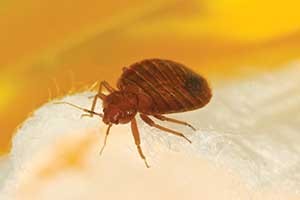Q. We service a community college. When bed bugs are found in a dorm, the college pays for the dry cleaning of all clothing in the suspect area. The college learned quickly that’s an expensive tactic and asked us for an alternative. We’ve been thinking about putting dichlorvos strips in plastic bags of clothing for a few days. Would that work? Is there another option? JOHN B., TENNESSEE
A. To ensure total kill, the clothing should be exposed to the dichlorvos strips for three to four days minimum. The time delay could be a factor, however, and there’s a possible liability issue for putting chemicals in touch with clothing.
Heat is a better option: 130° F for 15 minutes should provide total kill of all stages. Most clothes dryers reach this temperature. Heat is quick, and there are no toxicant liability issues. However, certain fabrics can be ruined in a dryer, so make sure a waiver is signed. The college should consider investing in several dryers for this purpose.
Q. What will the termite-swarming season be like this year? I’ve found swarmers in infested wood, so I suspect swarms will be good. What affects swarming? It seems like swarms aren’t consistent. GEORGE F., IOWA
A. Unfortunately, I don’t know — but 2015’s swarms will be minimal as in recent years. The fact that you found swarmers in infested wood isn’t uncommon. In your area, swarmers typically produced in mid-winter and remain in the colony’s inner workings until the right set of environmental conditions causes workers to release them. Favorable conditions include sufficient moisture and proper temperatures.
Years ago, the “right” conditions included an overnight rain with sunny skies, followed by morning temperatures in the 70s. Even when conditions seem right, there’s been little swarming. There are a lot of theories, but no one seems to know definitively why this has changed.
The question is, what happened to the swarmers present in colonies? They either died and/or were cannibalized by the workers. Swarmers contribute little, if anything, to the parent colony. They become a drag on the colony and are eliminated. All of this suggests the industry needs to stop focusing on swarms — and look for other ways to generate termite business.
Some companies have begun to install monitoring systems around customers’ homes, for example. Swarmers are often found in the monitors, even when swarming never occurs. The presence of swarmers in monitors indicates there’s an active colony on the premises and some treatment should be made. These systems can be installed and monitored for regular customers, with little expense to you.
Stop waiting for the phone to ring off the hook in swarming season, and begin monitoring to grow your termite business.
Q. How far can termite swarmers fly? JOHN D., NEW YORK
A. Termite swarmers can’t fly. They get up into the breeze and are carried by the wind to other areas. If swarmers try to fly, their wings break at the suture points and drop to the ground.
Email your questions about insect identification and pest management technologies and techniques to Dr. Doug Mampe, an industry consultant, at dentomol@aol.com. Your questions most likely will be printed and answered in one of Pest Management Professional’s upcoming Ask the Expert columns.

Leave A Comment